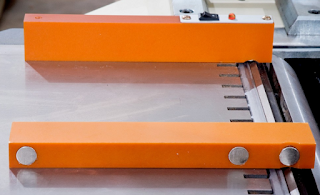I am a fan of Trend products as all of their professional products, routers, safety equipment, cutters etc that I own are top quality and built to last. However the T4 router is garbage here's why:
I needed a small plunge router and the Trend T4 seemed to fit the bill and at the current Amazon price point also seemed to be a bargain. I ordered one. The router itself is a 850 watt 1.1 HP machine with a plunge base which has a 30mm (1" 1/4) plunge. It comes with a pressed steel adjustable fence, a few tools, 3 sizes of collet (1/4", 6mm and 8mm), a transparent plastic dust shroud, instruction manual all enclosed in a blow moulded carrying case.
 |
| The dreaded T4 |
The router has an electronic variable speed control mounted on the top of the motor which goes from 11500 to 32000 rpm. The highest speeds are intended to be used for die grinding as the plunge base comes off the motor making it a hand held die grinder. For routing the manual recommends setting the variable speed control to 4 which is around 24000 rpm. The plunge mechanism itself it very smooth with external springs over the plunge shafts. There is a 3 position turret stop and a continuously variable plunge stop. The on off switch is conventiently located on the front of the router and is easily latched and unlatched. The plunge lock lever is on the rear and is in the roght position for an index finger to control.
The router and its cast aluminium plunge base are all well made and look as though they will hold up to light use. The router itself is marketed as hobby/DIY/light trade usage and as I just wanted it for occasional use it would probably suffice. I intended to dedicate it to pattern copying using guide bushes and removable collars to route cavities the exact size of cover plates. My Trend T11 is great at this but is too heavy - hence the need for a lighter smaller router.
All seems good so far.
 |
| Guide bush and collar |
 |
| Trend T11 - I love this machine |
First of all some explanation of guide bushes and the Trend T10/T11. I have an extensive set of guide bushes/collars - they are all standard across Trend routers - and decided to fit one to see how concentric the motor shaft is to the base. On the T10/T11 there is a sub plate that is fitted first of all and a centralization shaft (line up pin in Trend speak) is fitted into the collet. A 30mm guide bush is fitted to the subplate (innerplate in Trend speak) and the whole assembly is manoeuvred on the plunge base to get it exactly central on the shaft. Screws lock it into position. The guide bushes are fixed to this plate with countersunk screws so if you put one of a different diameter in place it will always be concentric.
 |
| Guide bush installation instructions for a T10/T11 router |
And now the T4. The T4 has no provision for an adjustable subplate and the guide bushes are intended to fit into a machined recess in the plunge base. There is no adjustment at all! The router also does not come with a setting centralization shaft either. It came as no surprise that the guide bush was
not concentric to the motor shaft. It was out of alignment by a considerable amount (around 1/16"). There was absolutely no way of adjusting this and for the intended purpose I had for the router it was impossible to use.
It does not come up to the high standard of the rest of Trend's products and I can't understand why they would have let this on the market with such a fundamental design flaw. It couldn't be used as I intended nor could be used in a dovetailing jig. It could however be used quite successfully for bearing guided pattern routing, edge guided routing, die grinding and normal routing duties very well.
So I have started the process of sending the router back as "not fit for purpose" without even making any dust.
I think if it wasn't for this major manufacturing/design problem the router itself would be OK.














